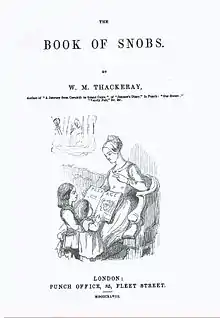The Book of Snobs
The Book of Snobs is a collection of satirical works by William Makepeace Thackeray published in book form in 1848, the same year as his more famous Vanity Fair. The pieces first appeared in fifty-three weekly pieces from February 28, 1846 to February 27, 1847, as "The Snobs of England, by one of themselves", in the satirical magazine Punch. The pieces, which were immensely popular and thrust Thackeray into widespread public view, were "rigorously revised" before their collection in book form and omitted the numbers which dealt with then current political issues (numbers 17–23).[1]
 Title page of the first publication | |
| Author | William Makepeace Thackeray |
|---|---|
| Illustrator | William Makepeace Thackeray |
| Country | United Kingdom |
| Language | English |
| Publisher | Punch Office |
Publication date | 1846–1848 |
| Media type | |
| ISBN | 0-8095-9672-5 |
The Book of Snobs expressed Thackeray's conscious and unconscious views on the snobbery prevalent in Victorian society. Thackeray initially adopted several pen names to remain anonymous, including the pseudonyms: Théophole Wagstaff, Charles Yelowplush, Major George Fitz-Boodle, Michael Angelo Titmarsh, and Ikey Solomons, Miss Tickletoby, Manager of the Performance, Arthur Pendennis, Timothy Titcomb, and Solomon Pacifico.[2] Thackeray only admitted authorship of the work in the second edition of Memoirs of Barry Lyndon (1856). The book took a critical view of the various groups of England and abroad, particularly France, and highlighted the human tendency to give importance to trivial matters or to admire things of low value. Thackeray described these traits succinctly in two phrases: "give importance to unimportant things" or "meanly admire mean things".
Upon publication, the book received a range of reviews, from mixed to generally negative. While the book received a defence from Anthony Trollope, other prolific writers of the time were critical of its often harsh, satirical and iconoclastic commentary on English and French societies. Nevertheless, its underlying message communicated a humanitarian and Christian-centric view.
The book has been translated into French several times, with notable versions by Georges Guiffrey in c.1857, by Maurice Constantic-Weyer, and by Raymond Las Vergnas in 1945.
The term 'snob' was popularised by the publication of the Book of Snobs. This compilation was highly influential in clarifying the current connotations of the word[3] and, in the words of academic and scholar Frédéric Rouvillois, in establishing "the baptism of snobbery".[4]
Origins of the Word 'Snob'
In the Dictionnaire du snobisme by Philippe Jullian, the term 'snob' is referenced: "the very sound of the word 'snob', which begins as a whistle and ends as a soap bubble, destined it for a great career in the realm of contempt and frivolity".[5] This description is similar to Thackeray's coinage of the term, but he adds a moral connotation.
References
- Ray, Gordon N. (June 1955). "Thackeray's 'Book of Snobs'" (PDF). Nineteenth-Century Fiction. 10 (1): 22–33, 22 & n.1. doi:10.2307/3044371. JSTOR 3044371.
- Colby, Robert A. (1920). Thackeray's Canvas of Humanity: An Author and His Public. Ohio State University Press. p. 4. ISBN 0814202829.
- "Qu'est-ce qu'un snob?". Bibliobs (in French). 21 November 2008. Retrieved 16 July 2023.
- Rouvillois, Frédéric (2008). Histoire du snobisme. Au fil de l'histoire. Paris: Flammarion. ISBN 978-2-08-120542-0.
- Jullian, Philippe (2006). Dictionnaire du snobisme (Nouvelle éd. ed.). Paris: Bartillat. ISBN 978-2-84100-378-5.
External links
- The Book of Snobs at Project Gutenberg
- The Book of Snobs at the Internet Archive
 The Book of Snobs public domain audiobook at LibriVox
The Book of Snobs public domain audiobook at LibriVox
